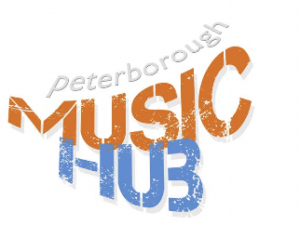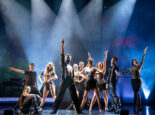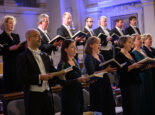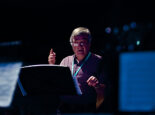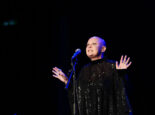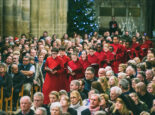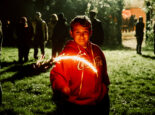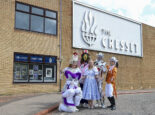Rhythm of the ages
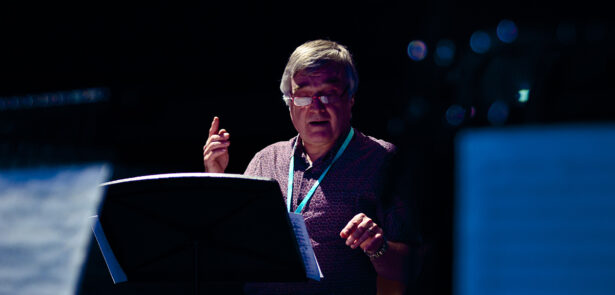
On Sunday, 17 March the City of Peterborough Symphony Orchestra present their much-anticipated spring concert, with a programme of British music including pieces by Elgar and Vaughan Williams. Joining them will be young musicians from Peterborough Centre for Young Musicians (PCYM) to premiere a brand-new piece by a British composer, PCYM teacher and Peterborian Martin Bright. Entitled Apkallu: Protector this vibrant, atmospheric piece has been written specifically for the PCYM Percussion Ensemble to perform with CPSO – and it looks set to give those young musicians an experience they’ll never forget. The Moment talks to Martin about the piece and how it’s all coming together.
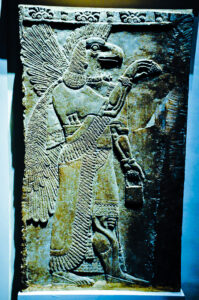 This is a completely new, commissioned piece – how did it come about?
This is a completely new, commissioned piece – how did it come about?
A few years ago, one of my pieces, Reeds Sway at Water’s Edge was performed by the PCYM percussion ensemble at a concert in Peterborough Cathedral. The chair of the City of Peterborough Symphony Orchestra, Deirdre Culloty, was really impressed with the students’ playing, and some time later when we were working together in an orchestra in Stamford – actually in the pit during the interval – this idea was born. The orchestra was going to be celebrating its 30th anniversary in 2020, and they wanted to encourage young people to be more interested in the orchestra, included playing in it, so they thought they could have something with a youth base as part of the anniversary concert. It feeds both organisations really well. And it certainly gives the more senior students the ability to have another orchestral experience with adults away from Peterborough Youth Orchestra, and also gives them a greater repertoire. We were in final rehearsals when Covid struck, so the concert never happened (which was very costly to the orchestra, financially). It’s taken this long for the CPSO to be able to fund putting on my piece again. I’m very grateful to them for continuing with our project albeit four years later. I’m also grateful that PCYM is also still able to give its support again, to help make the concert possible. So that’s how it all came about – and they gave me complete carte blanche with regard to the piece!
What is the idea behind the piece?
For a very long time I’ve been interested in the ancient Assyrian sculptures at the British Museum. They’re right near the Egyptian gallery, which is completely rammed all the time, then you go around the corner to this other gallery and you’re often on your own. They are these amazing bas-relief sculptures showing various aspects of the lives of the ancient Assyrians. Among them are characters that keep coming up, these rather strange half-man, half-animal beings, and one really caught my eye – partly because I’m also into bird watching – an eagle-headed man with four wings. Quite a powerful figure! These figures are part of their ancient religion and nobody seems to know the real names of them, but collectively they’re known as ‘Apkallu’. The Apkallu were put on the corners of the doorways in the palace of Nineveh to protect people, preventing evil spirits coming in. So the piece is called Apkallu: Protector. It gave me an opportunity to be completely fanciful about what could be going on in that world. It’s in six movements, which are connected. The first five of the six are about how the humans related to their religion and these beings. There are three dance episodes, a more solemn procession, a quiet moment of reflection and the giving of offerings – basically my interpretation of what I think might have been going on in their religious rituals. The last movement kind of goes into a different sphere and becomes otherworldly and more atmospheric, using more exotic instruments.
Even when you have complete freedom with the subject, presumably you still have to work to your players’ abilities?
Yes, I had to make it playable, and as far as the soloists were concerned the parts were written with their capabilities in mind, because we have a wide range of skills within the percussionist ensemble at PCYM. Principally, that’s because of age and development. One of them is still at primary school, and one is nearly leaving senior school. Some do music as a hobby, others are looking at it as a career; two of them, definitely – possibly three – actually want to be professional musicians. So, there’s quite a range of aspirations and skills, and each part was written specifically for the person playing it. However, it’s four years on now and only one of the students playing in the concert was there in 2020.
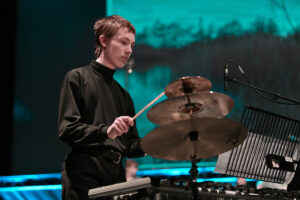 In a sense, isn’t this exactly what PCYM is all about – different ages and abilities playing together?
In a sense, isn’t this exactly what PCYM is all about – different ages and abilities playing together?
Yes – and we also have a habit of putting the whole of PCYM together to perform a large-scale piece. Previously, we performed a version of Mars from Holst’s Planets Suite at the Schools Make Music concert at the Cresset, and we’ve worked on some music from Carmen, which I am also conducting. It’s all hands on deck – everybody playing in the same room at the same time, and we use the BBC Ten Pieces, which are specially scored for different grade levels, so we can have good players with years of experience and beginners playing at the same time in a way that sounds good.
Last time we spoke – in relation to Reeds Sway at Water’s Edge – you said that even though you compose to their abilities you don’t let the players off the hook too easily!
There are challenges for the orchestra and there are definitely challenges for the students, but it’s all part of their growth and experience. I wouldn’t deliberately write something overly easy for them! There are parts that are easy, but also parts that challenge them.
What stage are you at with rehearsals?
The ensemble has been practicing since September, with a few modifications along the way, but the first full rehearsal happens soon. I think the students will realise how complex it is playing their piece with the orchestra! The way I’ve written it, because it’s something of a fantasy piece, there’s a lot of blurriness, and things aren’t always obvious. For example, when the winds start playing, the first thing they do is a run up to a high note, but they don’t all do it at the same time – they all arrive at the high note at different times, so it kind of blurs and evolves into this single high note. A lot of the piece does that kind of thing; I was telling them after a recent rehearsal that in order to make that work you’ve got to really own and be confident in your own part. Only two out of the five in the ensemble have had orchestral experience before.
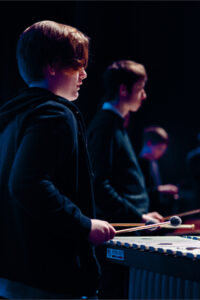 What range of instruments will they be playing?
What range of instruments will they be playing?
Between the six of them they’re playing 26 percussion instruments. Most people in the ensemble have their own setup: they’ve all got a tuned percussion instrument; at one end a very large marimba, then vibraphones, a set of crotales and a glockenspiel. Then they all have a drum of some sort – or sometimes more than one – and on top of that smaller percussion instruments. Near the end where it gets more otherworldly they’re also using singing bowls and exotic chimes.
How does it feel to be in the company of Elgar and Vaughan Williams?
I feel very honoured to be in such company. The Elgar and the Vaughan Williams have lots of variety in style and mood, so hopefully, my piece will share that sensibility. It makes a lot of sense to programme a couple of very familiar pieces along with a brand new work – and the pieces that are familiar to the audience are also probably more familiar to the orchestra, which means they can focus more on the new piece in rehearsal. I’ve tried with this piece to also feature the orchestra as much as possible, so it gives most of the players a bit of a workout!
How long was that process of writing the piece?
It took me ages! I started right after I got the commission. After signing to do it I actually had a new theme come into my head as I drove home, and that became part of it. I tend to work that way; don’t suffer from writer’s block or anything. But even so, it took me from November 2018 to January 2020!
Is orchestrating a piece like this challenging?
Orchestrating it is part of the fun – and the way I work, I actually hear the instruments in my head. So apart from a few practical considerations, like what an instrument can physically play, it kind of came out finished, so I knew who had to play what and when. I could hear it as an orchestra.
How do your young players respond to the work?
They’ve always committed themselves fully to the project; they take it as seriously as I do, and that’s what makes it work. I really appreciate that, because it’s a lot of work for them – they’ve got homework and other school activities to do – and yet they always come prepared, and by the time we do the concert I know it will be ready. I’ve also had one of them tell me how much they enjoy playing my music, and they’ve always been very proud of what they’ve done. You can see it in their faces at the end of a gig, and it’s great to see. When we did the first rehearsal I said: ‘This is amazing – I can actually hear it for real now, not just on a computer with naff sounds!’ Hearing it being played by real people is just lovely.
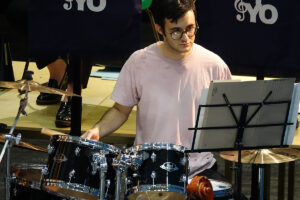 Is this level of involvement an important feature of PCYM in general?
Is this level of involvement an important feature of PCYM in general?
One of the things that Kirsten Goldthorp has done at PCYM is that she has staffed it with professional players who have a wide range of experience and skills, so pupils are working with real musicians. I think that’s a really big benefit, and perhaps one of the reasons why it’s picking up so well. The way we work, it is fun. But it’s also a proper professional environment, so they get to see the way it is for real. And it’s the little things, sometimes. In a professional rehearsal environment, if somebody is being directed and the others aren’t playing, they’re not talking or playing their instruments, they’re sitting quietly. And we do that. We run it the same way with the little ones as you would with a professional orchestra. It’s about expectations, and because we hone them at that early age they see how it really is. And there are so many personal skills that music – and ensemble playing especially – contributes to. I can certainly see how the members of my ensembles have come on in leaps and bounds in terms of social skills, as well as musical skills. They make new friends with common interests outside of school. But giving them that additional musical experience on a Saturday will bring them on in school as well.
City of Peterborough Symphony Orchestra Spring Concert
17 March, 7.30pm
Queen Katharine Academy
Vaughan Williams
English Folk Song Suite
Martin Bright
Apkallu: Protector
CPSO commission
Elgar
Enigma Variations
Conductor: Bjorn Bantock
Peterborough Centre for Young Musicians
The city’s young musicians now have access to high quality music education via Peterborough Centre for Young Musicians. PCYM seeks to attract talented young musicians, in the earliest stages of learning, who are able to demonstrate a technical and musical fluency alongside those with more experience and skill. With support from Peterborough Music Hub the Peterborough Centre for Young Musicians is a collaboration between Ormiston Bushfield Academy and the Guildhall School of Music & Drama. Operating from the high-quality facilities at Ormiston Bushfield Academy, this exciting venture offers music training at weekends throughout the academic year.
Facebook: www.facebook.com/PeterboroughCYM
Twitter: https://twitter.com/PmhPcym
www.pcym.org.uk

